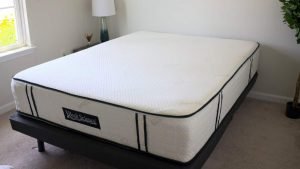What is a Duvet?
Are you in the market for new bedding and curious about the different types available? Maybe you’ve stumbled across the term “duvet” and wondered what it means. Or perhaps you want to know the difference between a duvet and a comforter. In this post, we’ll discuss everything you need to know about duvets – from what they are to how to use them, how they differ from other types of bedding, and why they’ve become a popular choice for modern-day sleepers.
- Last Updated: February 13, 2023

Understanding Duvets
A duvet is a soft blanket traditionally filled with feathers. More recently though, duvets may also be filled with natural or synthetic materials such as down-alternatives, or wool. Generally, duvets are used as the top layer of bedding to keep the sleeper warm. In fact, they are warm enough to be used without a flat sheet or additional blankets.
Duvets, also known as duvet inserts, are designed for use with a duvet cover. This protective layer is easily removable and machine-washable, which makes caring for your duvet simple and straightforward.
You’ll need to purchase a duvet and a duvet cover to complete your bedroom setup. Duvet sets typically include the cover, and matching pillow shams. The insert is generally sold separately, allowing you to mix and match styles without having to purchase a new duvet each time.
Duvet vs Duvet Cover
So, what is a duvet cover used for? A duvet cover is to a duvet what a pillowcase is to a pillow. It is the protective outer casing that contains the duvet inside. The insert is placed inside the duvet cover and closed up on one end with buttons, ties, or a zipper.
Duvet covers are available in a wide array of materials such as linen, cotton, flannel, and bamboo. Keep your sleep preferences in mind when shopping for a new cover. What you choose will shape your sleep experience. For example, some materials are better at keeping you cool, while others are better at keeping you warm.
Can You Use a Duvet Cover By Itself?
While a duvet cover can be used on its own as a top sheet, it may not provide much warmth or comfort without an insert. In the summer, when a duvet insert may be too warm, we’d recommend a lightweight option, such as the bamboo duvet by Cariloha.
To choose the correct duvet insert for the seasons, consider the fill and weight of the duvet. A higher fill amount indicates better insulation, making a duvet warmer. For the winter, look for a higher amount of fill and aheavier duvet weight. In contrast, for the summer, select a lighter weight duvet with a lower fill amount.
Additionally, some duvets are labeled with a specific season to indicate the appropriate temperature range. Keep in mind your personal preferences and local climate when choosing a duvet insert.
What is the Difference Between A Duvet And A Comforter?
The word duvet is often used interchangeably with comforter. While they share some similarities, they are not the same. While duvets should always be used with a duvet cover, comforters do not require a protective cover. For this reason, duvets are easier to clean than comforters. Additionally, the cover can easily be swapped out with another to alter your bedroom’s design, this is particularly beneficial to those who like to constantly change things up.
Personally, I prefer duvets, especially for the guest room. There is nothing worse than having to wash a comforter everytime we have visitors stay over. With a duvet cover I can easily remove it and throw it in the washing machine with the rest of the bedsheets.
RELATED: Cozy Earth Bamboo Bedding Review
What Is A Comforter?
A comforter is a soft, decorative blanket often filled with down, silk, wool, cotton, or polyester. They are typically quilted to keep the materials evenly distributed and firmly in place. Comforters may be less effective at trapping heat when used by themselves. As a result, they are often paired with additional sheets and blankets.
You can purchase a comforter by itself or as part of a set. Comforter sets, or bed-in-a-bag sets, typically come with the comforter and a fitted sheet, flat sheet, pillowcases, and decorative pillow shams. This is an easy, cost-effective way to give your bedroom some style!
Duvet vs Comforter
So which type of bedding is right for you? There is no right or wrong answer. Choosing a comforter vs a duvet is ultimately a matter of personal preference. It’s helpful to consider the pros and cons of each when shopping for bedding.
Why Choose a Duvet?
Choose a duvet if you want hassle free cleaning or enjoy frequently changing your design or decor. Many people find it easier to make the bed when using a duvet; that’s because you don’t need the flat sheet to protect your duvet, the cover does that instead.
Pros
- Easier to clean
- Lightweight and warm
- Easily change your bedroom style by swapping out your cover.
Cons
- Tendency for insert to bunch inside the cover
- Covers can be difficult to take on and off
- Initial cost may be more expensive than a comforter
Why Choose a Duvet?
Choose a comforter if you don’t want the hassle of assembling a duvet or you want an all-in-one ready to go bedroom design.
Pros
- Does not require assembly
- Often sold in sets which include everything you need to make your bed up
- Initial cost may be less than a duvet
Cons
- Harder to clean
- Not as warm as a duvet
- You can’t change your design without purchasing a new comforter
Conclusion
In conclusion, a duvet is a type of bedding that provides warmth and comfort while you sleep. Duvets are available in various weights, fills, and materials, making it easy to find the perfect duvet for your needs. While duvet covers are optional, they are a practical addition to any bedding setup, protecting your duvet and making it easier to clean. With this guide, you should now have a better understanding of what a duvet is, how it differs from other types of bedding, and how to choose the right duvet for your sleeping preferences.












